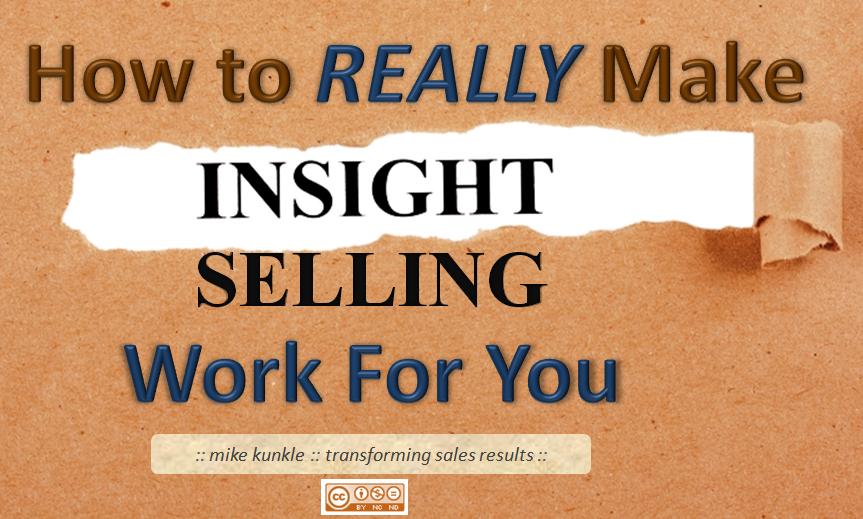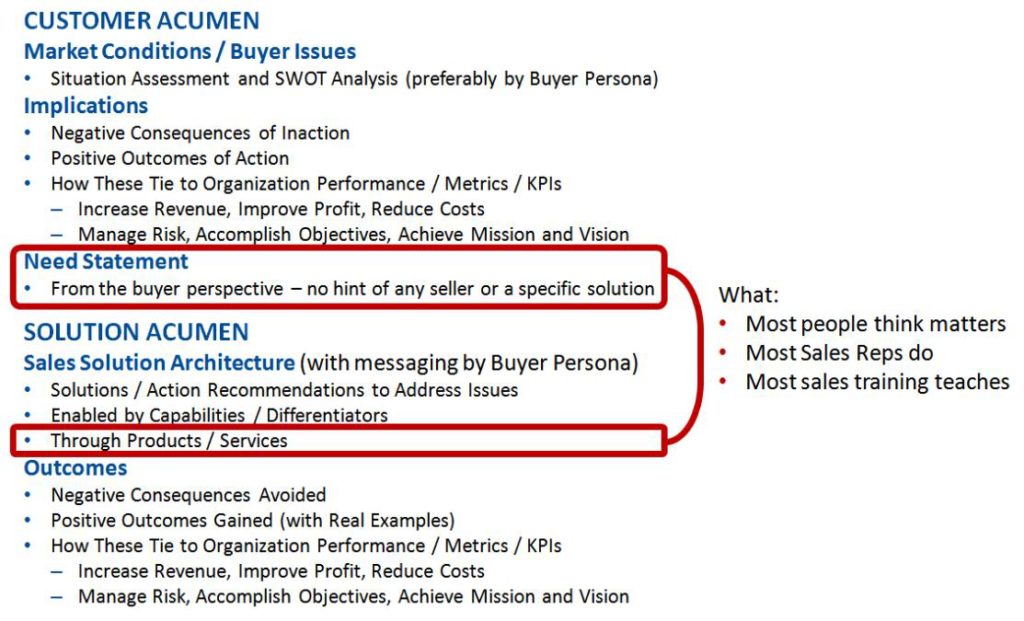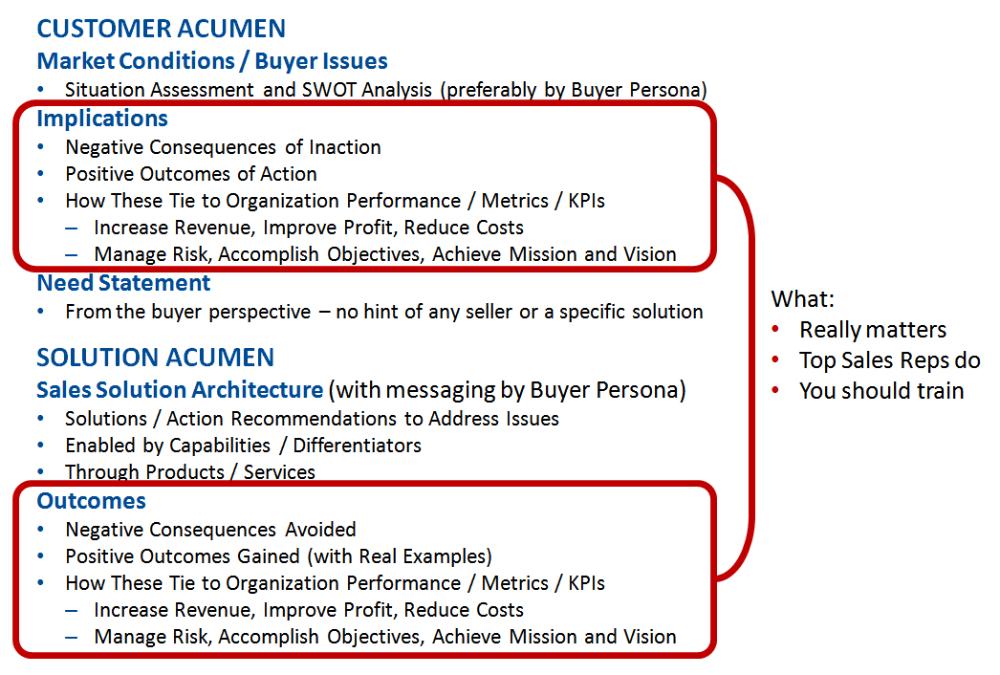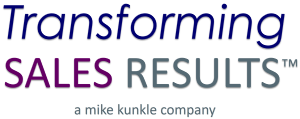How to REALLY Make Insight Selling Work

Call it what you will… insight selling, changing the sales conversation, selling with insights, challenging, influencing through thought leadership… it’s all the rage, isn’t it?
So much so, that some companies that shouldn’t be doing it are trying like crazy to scale the concept, and some that should be adding insight selling to their methodology mix, are rushing forward without nearly enough thought about how they will align sales and marketing, enable their sales force, and lead the real change that needs to occur in their organizations.
While I never condone a mismatched sales methodology or a “Ready, Fire, Aim” execution, I do understand the pressure that sales leaders feel, and why this is happening.
Sales Leaders Under Siege
One reason insight selling is popular, is that it’s a response to the sales dilemma that buyers are doing their own research and delaying the engagement with possible suppliers. Sales leaders want their reps to cut through the clutter and noise, capture attention, foster credibility, gain interest, and hopefully spur an opportunity by influencing the buyer to see things in a new way, preferably creating an opportunity in the process (to avoid the crowded glut of other suppliers that would be vying for the same business, spurring a price war).
Combine the changes in buyer behavior and the market pressures today with the hopeful outcomes above and the fact that the senior sales leaders in companies today are turning over every 18-24 months, and it’s at least understandable why they’re seeking silver bullets or rushing forward without fully-aligned and vetted plans.
With all that said, I thought I should share a few insights <wink> about how to make insight selling work, if you’re going down that path. My standard disclaimer applies here… this is a post, not a book, so it can’t be as detailed as I’d like, but I hope it will offer some helpful guidance or provide some food for thought.
Reminder: Sales Nuance and the Sales Utility Belt
One-trick ponies rarely succeed in the complex world of B2B professional selling today. Based on your Sales Nuances and the specifics of your marketplace, industry, company, customers and solutions, you need to load your sales force’s Sales Utility Belt with a variety of best-practice methodologies, to generate quality opportunities you can win and move them from one sales process stage to the next as efficiently and effectively as possible. In that sense, insight selling is just one tool in the Sales Utility Belt. There is no silver bullet, no miracle cure, no magic elixir. And if you try to put something as complex as insight selling into the belt without having a solid foundation of consultative selling skills, especially diagnostic and dialogue skills… well, your cart will be so far in front of the horse that the horse won’t see it. (Never good for the horse, the cart, or the driver.) Forewarned is forearmed.
Remember: Insights may be needed in some cases to gain entrance or change the buyer’s perceptions. But insights are a starting point. Beyond introducing relevant new data or an intriguing point of view, you must be able to lead an ensuing deeper dialogue and continue the conversation to create or co-create real value for the buyer.
Caterpillar + Readiness + Cocoon + Time = Butterfly
Readiness Phase
The oddest thing about the whole insight selling craze is that leaders forget that to sell with insights, you need to have… well… actual insights.
You need research, ideas, thought leadership, or a Point of View – something that is relevant and unexpected, unique or compelling. (See this post on Why Selling is a Joke as an example of what I mean.)
Depending on how your organization is structured and how you Go To Market and implement your solution, this is where R&D, Product Management, Market Research, Marketing, Sales Enablement, Operations, and other functions come into play. Someone needs to find or do research or create a competitive advantage, around which you can build insights to take to market, to change the sales conversation. The thing that’s far worse than not having an insight is trying to turn a snoozer into something compelling. This is not a case of “spin” or putting lipstick on a pig. You already have, can create, or can find insights, or you can’t.
Next you need alignment across functions about what your market messaging will be, and how the organization will back it up.
Example: If you’ve done something innovative recently to radically improve the speed and quality of your implementation, you want to message that appropriately, based on its impact to the various buyer personas in your market. But you also want to be sure you can scale the process, if your sales team brings in a wave of new business based on their promises and buyer expectations.
Don’t move forward to attempt a full implementation of insight selling, or something like it, without real insights or aligned readiness.
Cocoon Phase
How do you plan to transform your sales force? This is your Cocoon phase. It involves a lot of background work and dot connections between several of The Four Pillars of Sales Value Creation (also see this.)
Below, I’ll discuss the critical connections between Customer and Solution Acumen and where they intersect with Financial/Business Acumen. There are a ton of other things you can do to support the transformation, but don’t lose sight of equipping and preparing your sales reps (and sales managers!) Training prepares people, tools support people, compensation rewards people, but in the end, it’s mostly about the people – they are your real competitive differentiation – it’s the people who make things happen.
The Cocoon phase must involve a smart, well-designed, highly-customized training plan, probably involving blended learning to chunk, sequence and layer the prerequisite knowledge and then provide plenty of opportunity to put it all together in exercises, activities, role plays and realistic simulations, with feedback loops and behavioral coaching. Some of that can often be done virtually, but I’m still a hold-out believer that classroom training works extraordinarily well for sales training – provided you’re not teaching as much as you’re DOING what has already been taught. The Cocoon phase also involves immediate transfer plans, for getting the training out of the learning environment into the real world. Without that, it doesn’t matter how good your training is. This is where your sales managers play heavily, through buy-in, support, analysis (of what is being done and how well it’s being done) and ongoing coaching.
Time
Sales Mastery does not come overnight. Based on how well you “Cocoon,” you can come out of the gate strong and make a positive impact, but real mastery takes time and ongoing effort. As the old quote goes, the master cellist, Pablo Casals, still practiced in his eighties. When asked why, he said, “I think I’m getting better.”
I’ve written a lot about what I call Effective Learning Systems. I believe this is a prerequisite for getting the most out of the training investment above in Cocoon. Most companies fall horribly short of this and fail to retain the focus on sustainment and even better, mastery. Study John Kotter’s work on leading change and you’ll see the same. You can’t achieve greatness and tremendous levels of sales growth through Flavor Du Jour leadership. Focus on a few key things and execute like mad. If you can find something more important than focusing on your customers, products/services (value creation for customers), your sales force and your service delivery (to deliver the value to your customers), and internal cost reduction (to maximize profits but not at the expense of the former), write and let me know. (I’ll probably try to have you committed, but hey, write anyway, I enjoy the engagement.)
The Secret Sauce
I purposefully fast-forwarded past this piece, earlier, to leave it for now. But make no mistake, the path to sales growth is through customer focus. The dot-connections between your sales force’s Customer Acumen and Solution Acumen, and how they tie to the Financial/Business Acumen pillar (whatever the most important outcomes are, for your various buyers/decision-makers), is the secret sauce. (It’s not that secret, really, but I see it so infrequently, that it might as well be.)
CUSTOMER ACUMEN
How well do you know your market, your buyers, and their issues, concerns, and goals?
Market Conditions / Buyer Issues
- Situation Assessment and SWOT analysis (preferably by Buyer Persona)
Implications
- Negative Consequences of Inaction
- Positive Outcomes of Action
- How These Tie to Organization Performance / Metrics / KPIs:
– Increase Revenue
– Improve Profit
– Reduce Costs
– Manage Risks
– Accomplish Objectives
– Achieve Mission & Vision
Need Statement (buyer perspective with no hint of any seller or a specific solution)
How well do you know, and can you communicate, your solutions and how they address your customers’ issues (aka: how well can you create and communicate real value)?
SOLUTION ACUMEN
Sales Solution Architecture (with messaging by Buyer Persona)
- Solutions / Action Recommendations to Address Issues
- Enabled by Capabilities / Differentiators
- Through Products / Services
Outcomes
- Negative Consequences Avoided
- Positive Outcomes Gained (with Real Examples)
- How These Tie to Organization Performance / Metrics / KPIs:
– Increase Revenue
– Improve Profit
– Reduce Costs
– Manage Risks
– Accomplish Objectives
– Achieve Mission & Vision
Yes, this seems like basic stuff, but ask yourself:
- How often do you really see this happening, with mastery?
- How often does your website, your content, your marketing team, and your sales force, look or sound any different than your major competitors?
In my opinion, from a sales perspective, you need to look no further, if you want to create real differentiation.
Sidebar: Assuming of course, that in the Readiness phase, you identified something that creates differentiation… otherwise you are selling vapor and hoping for a miracle, or are content to settle for whatever market share you can grab naturally, by a sheer numbers game. If this is the case, go back to basics on Product Development/Product Management with a major reach-out to customers through Voice of Customer initiatives, Win/Loss Analysis, NPS, and advisory boards… and don’t stop until you figure out something better than the rest.
The Dot Connection You Don’t Want to Miss

Let’s take this one-level deeper before pausing today.
In my experience observing top sales producers, this a best practice can matter greatly in your insight selling approach. No matter how great your insight, chances are that it’s a ticket to entry – a door opener – to the real dialogue that will ensue. It’s in that dialogue that the magic happens, and you influence your buyer (assuming it is the right choice for them), to select your solution, address their issues and achieve their desired outcomes.
Most sales training still teaches the “Needs / Benefits match-up.” This is a core tenet of consultative selling, and I’m not saying you shouldn’t make this connection. I am saying it’s not enough to catapult your results beyond the norm.

What really matters is getting a level deeper, down to your buyers’ FUD (fear, uncertainty and doubt) and also to their goals, dreams, hopes and aspirations. It’s also about tying the outcomes to what they want to avoid and the critical KPIs that matter to the decision-makers (often financial, but not always – or perhaps, not only).
This isn’t an either/or thing, by the way. Use the pain-only approach, and you’ll motivate only those driven by moving away from things. That probably is the majority of people, but guess what? Those in senior roles – the folks with “the right stuff” who end up leading organizations and making big purchase decisions – they are far more motivated by accomplishment and what they want to make happen. They do move away from things, like most, but they often do it by moving TOWARD something. Don’t miss the boat here, by being a one-dimensional, one-trick pony.
I could go on for days, but have to stop somewhere. This is it for today.
There is a lot more to selling with insights, especially leading the dialogue and the delivery of the insight, but those critical pieces (and they are critical) still need to layer on top of these foundational elements, in my opinion.
That’s what I think.
What do YOU think?
I look forward to your thoughts, opinions and experiences.
As always, thanks for reading, be safe out there, and by all means, let’s continue to elevate our sales profession.
Mike
Follow my work and connect
- Advisory Services & Coaching Programs: TSR Advisory Services & Coaching 2024
- The Building Blocks of Sales Enablement Book: https://bit.ly/BBofSE
- The Building Blocks of Sales Enablement Course: https://GoFFWD.com/Blocks
- Sales Enablement Straight Talk Newsletter: https://bit.ly/MikeKunkle-LinkedInNewsletter
- SPARXiQ Blog: https://sparxiq.com/author/mikekunkle
- Distribution Strategy Group Blog: https://distributionstrategy.com/author/mike-kunkle/
- Sales Effectiveness Straight Talk Webinars: https://bit.ly/MikeKunkle-OnDemand(60 Free Recorded Webinars)
- LinkedIn Articles: http://bit.ly/MK-LinkedInArticles
- LinkedIn Profile: https://www.linkedin.com/in/mikekunkle
- X (formerly Twitter): https://twitter.com/mike_kunkle
- Instagram: https://www.instagram.com/mike_kunkle/
- TikTok: https://www.tiktok.com/@mike_kunkle
- YouTube: https://www.youtube.com/@MikeKunkle/videos (Please Subscribe!)
About Mike
Mike Kunkle is a recognized expert on sales training, sales effectiveness, and sales enablement. He’s spent over 30 years helping companies drive dramatic revenue growth through best-in-class training strategies and proven-effective sales transformation systems – and he’s delivered impressive results for both employers and clients. Mike is the founder of Transforming Sales Results, LLC and works as the Vice President of Sales Effectiveness Services for SPARXiQ, where he designs sales training, delivers workshops, and helps clients improve sales results through a variety of sales effectiveness services. Mike collaborated with Doug Wyatt to develop SPARXiQ’s Modern Sales Foundations™ curriculum and also authored the SPARXiQ’s Sales Coaching Excellence™ course. His book, The Building Blocks of Sales Enablement, is available on Amazon and The Building Blocks of Sales Enablement Learning Experience is available through FFWD.

